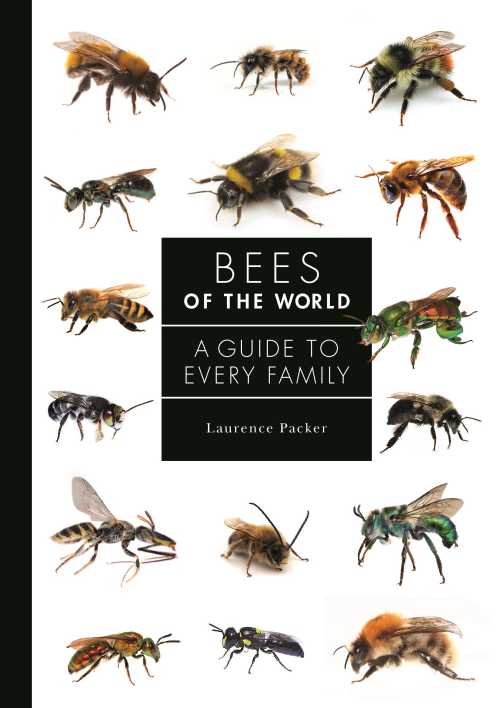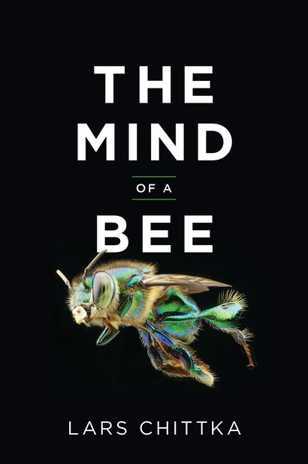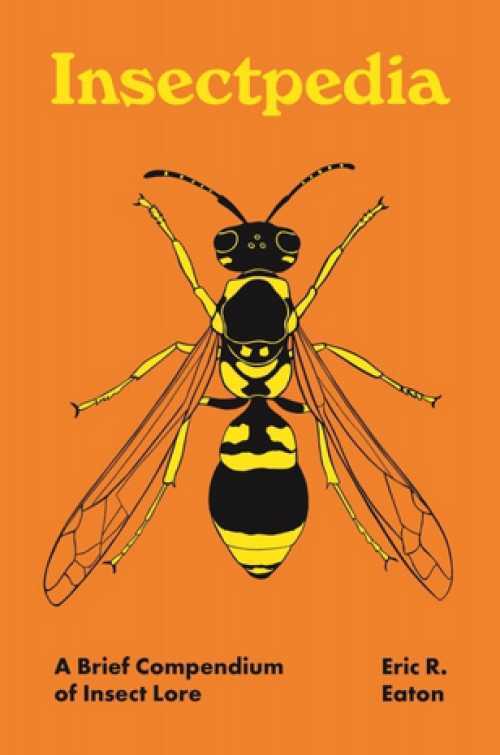Apidae Bee Family
Apidae is the largest bee family and includes honey bees, bumble bees and the large carpenter bees.
According to Packer (Bees of the World)1 there are almost 6,000 species in this group.
The Apidae Bee Family
Species within the Apidae bee family are included in the long-tongued category.
Some of them are corbiculate species (having corbiculae or pollen baskets on the hind legs) as a means to transport pollen, as opposed to scopa (hairs) on the underside of the abdomen or on the legs.
This bee family includes eusocial, solitary and socially parasitic and an 'exceptionally high proportion of cleptoparasitic species'2.
(Cleptoparasites are brood parasites in the nests of other bees2).
Many species within this family are very important pollinators and a few are managed for their pollination services.
Over 200 genera belong in this group3. It's beyond the scope of this page to cover all of them. Below are some of the genera explored on this website which are included in the Apidae bee family.
The Subfamilies
Five subfamilies are currently recognised1.
Anthophorinae
Large, hairy bees with 7 genera and almost 750 described species1.
Apinae
Six genera are in this subfamily, two of which are oil-collectors, and the rest are corbiculate bees (honey bees, stingless honey bees, bumble bees and orchid bees)1.
Nomadinae
A cuckoo (cleptoparasite) group with more than 1600 species, mostly in the Nomada genus1.
Eucerinae
A group recognised as a subfamily in 20181.
Xylocopinae
Has 3 genera and over 1,000 species1.
Example genera in this subfamily
Apis - The Honey Bees
Honey bees are widely studied and are vital for the pollination services they provide.
Honey bees are highly eusocial, and are regarded as superorganisms.
They are corbiculate, and workers can sometimes be seen carrying pollen in compact pollen loads on the hind leg.
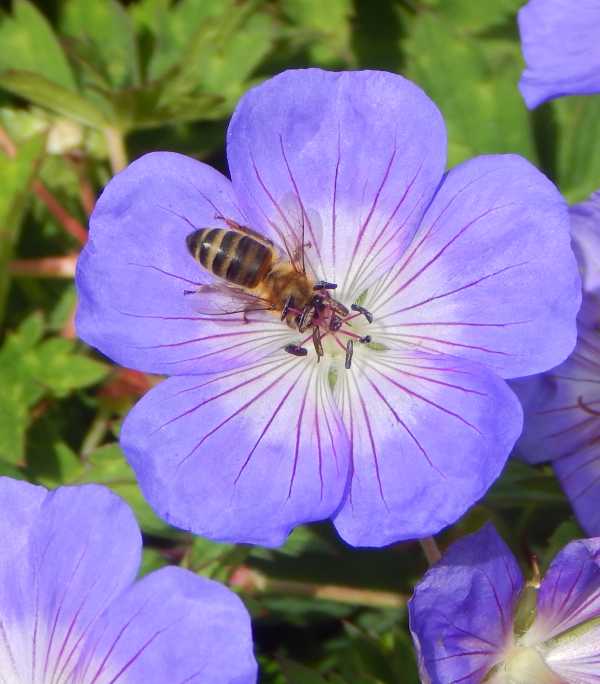 Apis mellifera
Apis melliferaThey also are managed for the hive products they produce (honey, beeswax, propolis).
More recently, honey bees are used in Africa to protect farms from elephants.
In the wild, colonies may inhabit hollow tree trunks, caves and other crevices.
Apis mellifera (the Western Honey Bee) is probably the most widely known single species of honey bee.
Interestingly, Packer1 notes there is some debate about the number of species within the Apis genus, with some recognising 8 species, whilst others suggest there are more than 10, including the 'giant' honey bee group, such as Apis laboriosa (the abominable honey bee) found in the Himalayas1.
Bombus - The Bumble Bees
There are around 280 species in the Bombus genus1. They are eusocial.
Colonies are initiated by a single queen. Female workers are produced and assist with the raising of more workers followed by males and new queens (gynes).
Some species are cuckoos.
A number of insect species mimic the appearance of bumble bees, especially flies, such as Bombylis.
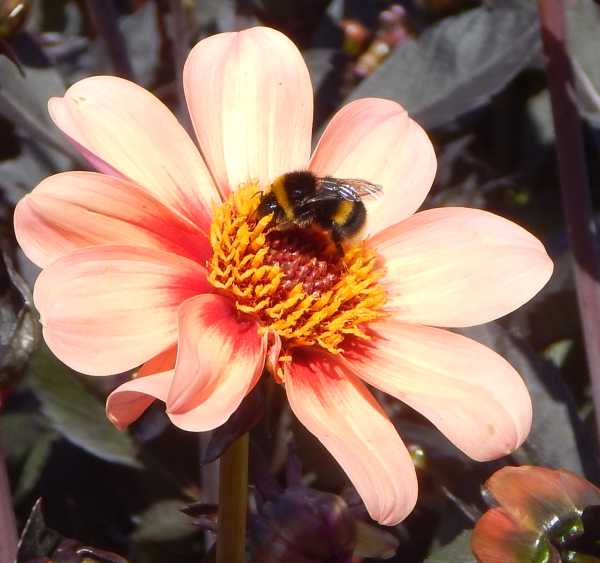 Bombus species
Bombus speciesAnthophora - The Flower Bees
Commonly called the flower bees, or sometimes digger bees (although 2 species nest in cavities rather than dugout burrows1). There are around 400 species in this genus, and some resemble worker Bombus species.
Anthophora have a large Dufour's gland which is used (at least by some species) in the secretion of a fatty substance used to line the wall of the brood cell. This lining (as well as the pollen ball) is consumed by the emerging larvae1.
Xylocopa - Large Carpenter Bees
This genus includes 376 species1. These bees make their nests in wood or woody plant stalks.
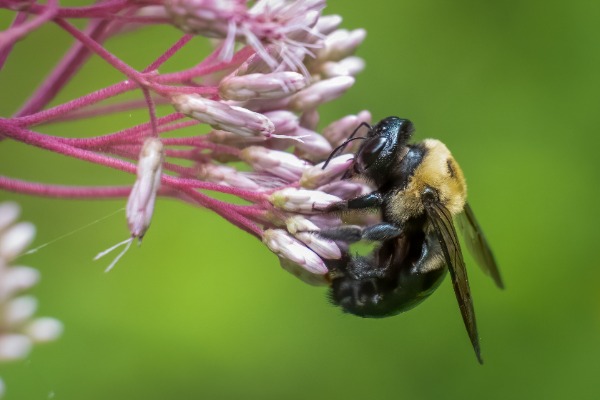 Xylocopa virginica
Xylocopa virginicaThese species are able to buzz pollinate and are efficient pollinators of some food crops.
Xylocopa eggs are comparatively large.
Ceratina - Small Carpenter Bees
These are small, dark bees with a metallic blue or green sheen on sparsely-haired abdomen and thorax.
Around 370 Ceratina species have been described.
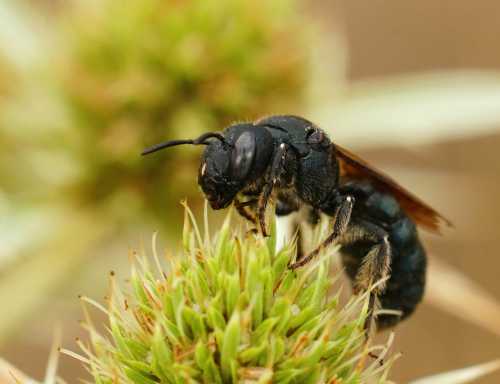 Ceratina chalcites
Ceratina chalcitesEucera - Long-horned Bees
These delightful bees gain their name from the males, which have notably long antennae.
Packer notes this genus has grown from around 220 species to over 3801. It includes the Hoary Squash Bee (Eucera pruinosa), an important pollinator of Zucchini in North America1.
Read about a species of Long-horned Bee.
Nomada - Nomad Bees
These small, waspish bees are cuckoos that primarily target Andrena (mining bees), but will also attack halictids, melittids and Eucera.
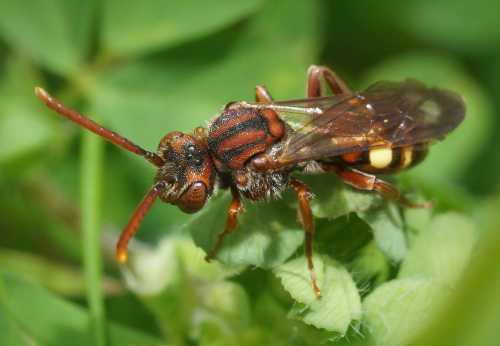 Nomada ruficornis
Nomada ruficornisMore than 750 species have been described, making it the largest genus of cuckoo species in the world1.
Females deposit their egg in the nest of a target host. The Nomada larva will destroy and kill the offspring of the host.
Trigona - Sweat Bees
This genus includes small stingless bees which collect sweat from animals (and humans).
See - How Did Sweat Bees Get Their Name?
Euglossa - Orchid Bees
Males are attracted to orchids from which they gather scents from flowers which are then used to attract a mate.
However, orchids are not the only source of chemical baits - they may also be gathered from animal dung, rotting fruit and fungi!
Female Euglossa may also collect resins to waterproof their nests.
Bees Of The World - Book Review
References
1. Bees of The World: A Guide To Every Family, Laurence Packer. Princeton University Press, Princeton & Oxford, 2023; ISBN: 798-0-691-22662-0.
2. Cardinal S, Straka J, Danforth BN. Comprehensive phylogeny of apid bees reveals the evolutionary origins and antiquity of cleptoparasitism. Proc Natl Acad Sci U S A. 2010 Sep 14;107(37):16207-11. doi: 10.1073/pnas.1006299107. Epub 2010 Aug 30. PMID: 20805492; PMCID: PMC2941306.
3. Wilson & Messinger-Carril; The Bees In Your Backyard, Princeton University Press 2016.
If you found this page helpful or interesting, I'd really be grateful if you would share it with others - if not this page, perhaps another, such as Gardening For Bees.
Thank you so much :) .
